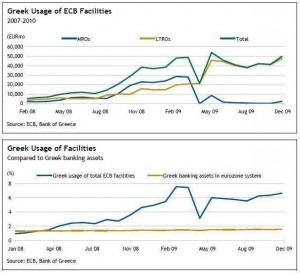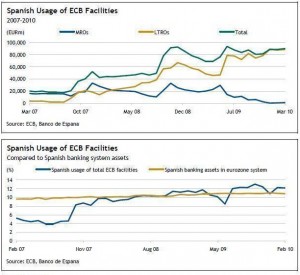Préstamos del BCE a los bancos griegos durante la crisis (fuente: FTAlphaville).
En un excelente artículo en FT-Alphaville, analizando una breve historia sobre la liquidez del sistema de la Eurozona nos ofrece muchos datos interesantísimos. Os adjunto primero una breve historia de la evolución de la liquidez del Sistema en la Eurozona:
* March 2008 – The ECB ups the amount of refinancing it provides via its Longer Term Refinancing Operations (LTROs). But at the same time the Bank reduces the amounts it allocates at its weekly operations, to keep the amount of total liquidity constant. At the end of March, the central bank is funding 2.1 per cent of total eurozone consolidated banking system assets, compared with 2.3 per cent at the end of 2006.
* September 2008 – As the financial crisis intensifies, the ECB increases its liquidity and foreign exchange provisions, for instance by continuing to shift to longer refinancing maturities. Still, by the end of September 2008, not all demand for longer term funding is being fully met by the central bank, so ECB lending is funding just 2 per cent of eurozone banking system assets.
* October 2008 – After the fall of Lehman Brothers, the ECB begins offering liquidity in unlimited amounts in euros, and in longer durations (the 1-year LTRO for instance) and other currencies via swap lines with other central banks. The Bank also expands the type of assets eligible as collateral for its repo operations — a measure that will come back to haunt it viz Greece and the rating agency furore. By November, the ECB is funding about 3 per cent of system assets.
The percentage of eurozone banking assets being funded by the ECB eventually spikes at about 3.7 per cent in the summer of 2009, and levels off to about 3 per cent by March 2010 — still at post-Lehman levels.
Uso de la financiación del BCE durante la crisis, por parte de los bancos irlandeses, (fuente: FTAlphaville).
Me sorprende las tremendas necesidades de financiación de los bancos irlandeses que llegaron a suponer a finales del 2008 un 19% del total del sistema cuando solo pesan un 6% del total eurozona. Mas desequilibrado han sido los bancos griegos que con solo un peso de algo mas del 1,5% del total consiguieron préstamos por casi un 8% de la Eurozona.
La pregunta seria quizás, ¿pero porque el BCE se los concedió?, ya que ha contribuido a desequilibrar al sistema bancario y financiero de la Eurozona.
Uso por parte de los bancos españoles de la financiación al BCE durnate la crisis, (fuente: FTalphaville).
Lo que mas me ha sorprendido es como los bancos italianos cuyos activos pesan un 12% del total de la Eurozona, solo han pedido prestados al BCE de media un importe que supone alrededor del 4% del sistema. Es decir que las tensiones y el exceso de endeudamiento no han venido del lado de los bancos privados italianos. De hecho Italia tiene un saldo de deuda publica superior al 100% de su PIB pero en los últimos 5 a 10 años se ha mantenido estable, lo que quizás también es un paralelismo en los bancos privados, no han necesitado de enormes necesidades de financiación.







Tweets that mention investorsconundrum.com - El Blog para el Inversor con Ideas Propias - Donde Invertir en Bolsa hoy » Que bancos europeos han recibido mayores préstamos del BCE -- Topsy.com
[…] This post was mentioned on Twitter by Marc Garrigasait. Marc Garrigasait said: Que bancos europeos son los que mas préstamos han recibido del BCE http://snipurl.com/wf21t […]
Que bancos europeos han recibido mayores préstamos del BCE | Top Bilbao
[…] more here: Que bancos europeos han recibido mayores préstamos del BCE Puesto por on May 17th, 2010 bajo Economía. Puede serguir las respuestas de este articulo RSS […]
Lluis Moncusi
Interesantes datos comparativos. Por lo que respecta a Italia, también es interesante comentar que el sector privado (empresas, bancos, Y FAMILIAS) está bastante menos endeudado que el español…
Es decir, si Italia modera el gasto público el consumidor no va tan ahogado como en españa y puede amortiguar el golpe; si necesita dinero aún puede endeudarse… en España ya estamos con pocas fichas y ALL-IN